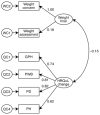Patient-reported outcomes following treatment with the human GLP-1 analogue liraglutide or glimepiride in monotherapy: results from a randomized controlled trial in patients with type 2 diabetes
- PMID: 20590735
- PMCID: PMC2901519
- DOI: 10.1111/j.1463-1326.2010.01196.x
Patient-reported outcomes following treatment with the human GLP-1 analogue liraglutide or glimepiride in monotherapy: results from a randomized controlled trial in patients with type 2 diabetes
Abstract
Aim: As weight gain and hypoglycaemia associated with glimepiride therapy can negatively impact weight perceptions, psychological well-being and overall quality of life in type 2 diabetes, we investigated whether liraglutide treatment could improve these factors.
Methods: Seven hundred and thirty-two patients with type 2 diabetes completed a 77-item questionnaire during a randomized, 52-week, double-blind study with liraglutide 1.2 mg (n = 245) or 1.8 mg (n = 242) compared with glimepiride 8 mg (n = 245).
Results: Mean (SE) decreases in glycated haemoglobin levels were greater with liraglutide 1.2 mg [-0.84 (0.08)%] and 1.8 mg [-1.14 (0.08)%] than glimepiride [-0.51 (0.08)%; p = 0.0014 and p < 0.0001, respectively]. Patients gained weight on glimepiride [mean (SE), 1.12 (0.27) kg] but lost weight on liraglutide [1.2 mg: -2.05 (0.28) kg; 1.8 mg: -2.45 (0.28) kg; both p < 0.0001]. Patient weight assessment was more favourable with liraglutide 1.8 mg [mean (SE) score: 40.0 (2.0)] than glimepiride [48.7 (2.0); p = 0.002], and liraglutide 1.8 mg patients were 52% less likely to feel overweight [odds ratio (OR) 0.48; 95% confidence interval (CI): 0.331-0.696]. Mean (SE) weight concerns were less with liraglutide [1.2 mg: 30.0 (1.2); 1.8 mg: 32.8 (1.2)] than glimepiride [38.8 (1.2); p < 0.0001 and p < 0.001, respectively], with liraglutide groups 45% less likely to report weight concern (OR 0.55, 95% CI: 0.41-0.73). Mean (SE) mental and emotional health and general perceived health improved more with liraglutide 1.8 mg [476.1 (2.8) and 444.2 (3.2), respectively] than glimepiride [466.3 (2.8) and 434.5 (3.2), respectively; p = 0.012 and p = 0.033, respectively].
Conclusions: Improved glycaemic control and decreased weight with liraglutide 1.8 mg vs. glimepiride can improve psychological and emotional well-being and health perceptions by reducing anxiety and worry associated with weight gain.
Figures

References
-
- Cryer PE. Hypoglycaemia: the limiting factor in the glycaemic management of type I and type II diabetes. Diabetologia. 2002;45:937–948. - PubMed
-
- Korytkowski M. When oral agents fail: practical barriers to starting insulin. Int J Obes Relat Metab Disord. 2002;26:S18–S24. - PubMed
-
- Nathan DM, Buse JB, Davidson MB, et al. Medical management of hyperglycemia in type 2 diabetes: a consensus algorithm for the initiation and adjustment of therapy. Diabetes Care. 2008;31:1–11. - PubMed
-
- Rubin RR. Adherence to pharmacologic therapy in patients with type 2 diabetes mellitus. Am J Med. 2005;118(Suppl. 5 A):27S–34S. - PubMed
-
- Rodbard HW, Jellinger PS, Davidson JA, et al. Statement by an American Association of Clinical Endocrinologists/American College of Endocrinology consensus panel on type 2 diabetes mellitus: an algorithm for glycemic control. Endocr Pract. 2009;15:540–559. - PubMed
Publication types
MeSH terms
Substances
LinkOut - more resources
Full Text Sources
Medical
Research Materials

